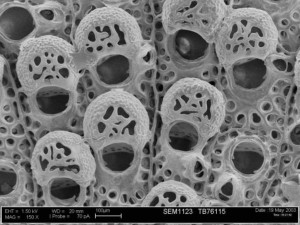Description
The encrusting bryozoan Hippoporina indica was described from waters near Bombay by Pillai (1978). 'Cosciniopsis hongkongensis', described by Liu and Liu fom Hong Kong (Liu and Liu 1992, cited by McCann et al. 2007), appears to be identical to H. indica (McCann et al. 2007).
Taxonomy
| Kingdom | Phylum | Class | Order | Family | Genus |
|---|---|---|---|---|---|
| Animalia | Bryozoa | Gymnolaemata | Cheilostomata | Hippoporinidae | Hippoporina |
Synonyms
Invasion History
Chesapeake Bay Status
| First Record | Population | Range | Introduction | Residency | Source Region | Native Region | Vectors |
|---|---|---|---|---|---|---|---|
| 2001 | Established | Unknown | Introduced | Regular Resident | Western Pacific | Western Pacific | Shipping(Fouling Community) |
History of Spread
The encrusting bryozoan Hippoporina indica was described from Bombay, India, on the Arabian Sea, by Pillai (1978). An apparently identical bryozoan was described from Hong Kong, China as Cosciniopsis hongkongensis by Liu and Liu in 1987, and had been present there at least as early as 1968).
Hippoporina indica was first collected and identified outside the Indo-West-Pacific region in 2001, at 3 sites in lower Chesapeake Bay, in Norfolk (Nauticus and Willoughby Bay) and Virginia Beach (Lynnhaven Bay) 7). In a survey of fouling taxa in East and Gulf Coast ports, in 2001-2005, H. indica occurred from Chesapeake Bay (VA) to Corpus Christi Bay (TX). This bryozoan was well established and abundant from Charleston southward (McCann et al. 2007).
Chesapeake Bay- Hippoporina indica was collected in 2001, at 3 sites () in lower Chesapeake Bay: Norfolk (Nauticus and Willoughby Bay) and Virginia Beach (Lynnhaven Bay) (McCann et al. 2007). One specimen was found at each site, but the occurrence at multiple sites was considered to indicate an established population
Charleston Harbor-Hippoporina indica was collected in 2004, at several sites (McCann et al. 2007).
St. Johns River Estuary- Hippoporina indica was found in 2001, at 8 sites near Jacksonville FL. It occurred only at the higher-salinity stations, but was very abundant (McCann et al. 2007).
Indian River Lagoon- Hippoporina indica was collected in 2004, at 7 sites near Fort Pierce FL and was very abundant (McCann et al. 2007).
Tampa Bay- Hippoporina indica was collected in 2002-2004, at many sites, and was very abundant (McCann et al. 2007).
Pensacola Bay- Hippoporina indica was collected in 2002, at many sites, and was very abundant (McCann et al. 2007).
Galveston Bay- Hippoporina indica was collected in 2002, at 9 of 10 sites, and was very abundant (McCann et al. 2007).
Corpus Christi Bay- Hippoporina indica was collected in 2002, at 7 of 10 sites, and was very abundant (McCann et al. 2007).
Hippoporina indica is known only from Bombay, India, (Arabian Sea) Hong Kong, and the nearby coast of China (South China Sea) and from the Atlantic and Gulf coasts of the United States. Its full native and introduced ranges may be much larger (McCann et al. 2007).
Invasion References: McCann et al. 2007; Pillai 1978
Invasion Comments
None
Ecology
Environmental Tolerances
| For Survival | For Reproduction | |||
|---|---|---|---|---|
| Minimum | Maximum | Minimum | Maximum | |
| Temperature (ºC) | ||||
| Salinity (‰) | ||||
| Oxygen | None | |||
| pH | ||||
| Salinity Range | poly-eu |
Age and Growth
| Male | Female | |
|---|---|---|
| Minimum Adult Size (mm) | ||
| Typical Adult Size (mm) | 20.0 | 20.0 |
| Maximum Adult Size (mm) | 50.0 | |
| Maximum Longevity (yrs) | ||
| Typical Longevity (yrs |
Reproduction
| Start | Peak | End | |
|---|---|---|---|
| Reproductive Season | |||
| Typical Number of Young Per Reproductive Event |
|||
| Sexuality Mode(s) | |||
| Mode(s) of Asexual Reproduction |
|||
| Fertilization Type(s) | |||
| More than One Reproduction Event per Year |
|||
| Reproductive Startegy | |||
| Egg/Seed Form |
Impacts
Economic Impacts in Chesapeake Bay
Hippoporina indica in Chesapeake Bay appears to be rare (McCann et al. 2007) so its present economic impacts are probably not observable.
Economic Impacts Outside of Chesapeake Bay
Hippoporina indica is abundant in estuaries of the southern East and Gulf Coasts and may contribute to fouling of ships, docks, and powerplants. In china, this species is a common fouler of aquaculture and fishing gear (McCann et al. 2007).
Ecological Impacts on Chesapeake Native Species
Hippoporina indica in Chesapeake Bay appears to be rare (McCann et al. 2007) so its present ecological impacts may be small. In estuaries of the southern East and Gulf Coasts, where this species is more abundant, its impacts on native biota may be larger, but have not yet been studied.
Ecological Impacts on Other Chesapeake Non-Native Species
Hippoporina indica in Chesapeake Bay appears to be rare (McCann et al. 2007) so its present ecological impacts may be small. In estuaries of the southern East and Gulf Coasts, where this species is more abundant, its impacts on other exotic biota may be important, but have not yet been studied. In India, its native range, H. indica grew more slowly than Electra bengalensis, and Sinoflustra annae, two other bryozoans which have also been introduced to Southeast and Gulf Coast estuaries, but persisted owing to its greater longevity and ability to overgorw other species (Karande and Udhayakumar 1992).
References
Karande, A. A.; Udhayakumar, M. (1992) Consequences of crowding on life-histories of cheilostome bryozoans in Bombay., Indian Journal of Marine Science 21: 133-136Madhavan Pillai, S. R. (1978) A new species of Hippoporina (Ectoproccta, Ascophora) from Bombay coast., Current Science 47: 61-63
McCann, Linda D.; Hitchcock, Natasha Gray; Winston, Judith E.; Ruiz, Gregory M. (2007) Non-native bryozoans in coastal embayments of the southern United States: new records for the western Atlantic., Bulletin of Marine Science 80: 319-342
